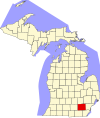Michigan Theater (Ann Arbor, Michigan)
Michigan Theater Building | |
U.S. National Register of Historic Places | |
Michigan State Historic Site | |
 Michigan theatre | |
 Show map of Michigan  Show map of the US | |
| Location | 603 E. Liberty St., Ann Arbor, Michigan |
|---|---|
| Coordinates | 42°16′46″N 83°44′31″W / 42.27944°N 83.74194°W / 42.27944; -83.74194Coordinates: 42°16′46″N 83°44′31″W / 42.27944°N 83.74194°W / 42.27944; -83.74194 |
| Area | less than one acre |
| Built | 1927 |
| Architect | Finkel, Maurice |
| Architectural style | Late 19th And 20th Century Revivals, Lombard Romanesque |
| NRHP reference # | 80001917[1] |
| Added to NRHP | November 28, 1980 |
The Michigan Theater is a movie palace in Ann Arbor, Michigan, United States. It shows independent films, stage productions and musical concerts.
Designed by Detroit-based architect Maurice Finkel and built in 1928, the theater seats 1590 and features the theater's original 1927 Barton Theatre Pipe Organ, orchestra pit, stage, and elaborate architectural details. It has been co-owned, off and on, with the State Theater for years, as both were originally under the ownership of the Butterfield Theaters chain.
Contents
1 History
2 Barton Organ
3 Theater description
4 Gallery
5 References
6 External links
History
The Michigan Theater opened on January 5, 1928, and was at the time the finest theater in Ann Arbor. The theater not only showed movies, but also hosted vaudeville acts, live concerts, and touring stage plays. Over the years, Jack Benny, Bing Crosby, Paul Robeson, and Ethel Barrymore all appeared at the theater.[2]
During a renovation in 1956, many of the original ornate designs were destroyed. After a period of low attendance, the theater was threatened with demolition in 1978, but members of the community and local organists helped raise funds to save and renovate the theater, returning it to its original design. A second screen with a state-of-the-art sound system, seating for 200 and the ability to project films digitally was added in 1999.
The Michigan Theater is the current home of the annual Ann Arbor Film Festival, the Ann Arbor Symphony, the Ann Arbor Concert Band, and Dandia Dhamaka, and has been named 2006 Outstanding Historic Theatre by the League of Historic American Theaters. The theater also hosts a series of children's stage productions entitled "Not Just For Kids" and a concert series entitled "The Legends of Rock & Roll."
Barton Organ
The Barton Opus 245 theatre pipe organ was built for the Michigan Theater and installed in November 1927 shortly before the theater was opened. It is one of the few remaining organs which exists in its original location. It has three manuals (keyboards), thirteen separate ranks of pipes and the console is situated on a functioning Barton four-poster lift. The instrument has been fully restored and has retained all of its original electropneumatic operating systems. No portion of it has been digitized and no such modification is planned. The instrument is professionally maintained and played daily prior to most film screenings, making it one of the most heard theater organs in the country.[3]
Theater description
The Michigan Theater Building is a large, two-story block building, consisting of the Michigan Theater itself and seven retail stores fronting the street, as well as offices above. The building's exterior is clad with brown brick with cement and terra cotta trim. The main section of the facade, three bays wide, contains the entrance to the theater and two flanking stores. This section is Lombard 'Romanesque in style. The remaining five storefronts are all to one side of the main section, and are considerably plainer. In the plainer section are two slightly recessed storefronts than flank the stair access to the second floor. In each section, the roofline parapet contains the name of the building.[2]
The Romanesque theater entrance contains cream terra cotta columns, arches, and other Romanesque elements on the second floor; these elements on the first floor were lost to the 1956 remodeling. Decorative aprons above the second-floor arcade sections contain green and blue terra cotta, and additional decoration is within the arches. [2]
On the interior, the inner lobby still retains original details, including a barrel-vaulted ceiling, Romanesque columns and arch decorations, wood paneling, and wrought-iron balcony and staircase railings. The auditorium also contains some of the original detail.[2]
Gallery

Console of the 3/13 Barton theatre organ at Ann Arbor's Michigan Theater

Theater lobby

East Liberty St at night
References
^ National Park Service (2009-03-13). "National Register Information System". National Register of Historic Places. National Park Service..mw-parser-output cite.citation{font-style:inherit}.mw-parser-output .citation q{quotes:"""""""'""'"}.mw-parser-output .citation .cs1-lock-free a{background:url("//upload.wikimedia.org/wikipedia/commons/thumb/6/65/Lock-green.svg/9px-Lock-green.svg.png")no-repeat;background-position:right .1em center}.mw-parser-output .citation .cs1-lock-limited a,.mw-parser-output .citation .cs1-lock-registration a{background:url("//upload.wikimedia.org/wikipedia/commons/thumb/d/d6/Lock-gray-alt-2.svg/9px-Lock-gray-alt-2.svg.png")no-repeat;background-position:right .1em center}.mw-parser-output .citation .cs1-lock-subscription a{background:url("//upload.wikimedia.org/wikipedia/commons/thumb/a/aa/Lock-red-alt-2.svg/9px-Lock-red-alt-2.svg.png")no-repeat;background-position:right .1em center}.mw-parser-output .cs1-subscription,.mw-parser-output .cs1-registration{color:#555}.mw-parser-output .cs1-subscription span,.mw-parser-output .cs1-registration span{border-bottom:1px dotted;cursor:help}.mw-parser-output .cs1-ws-icon a{background:url("//upload.wikimedia.org/wikipedia/commons/thumb/4/4c/Wikisource-logo.svg/12px-Wikisource-logo.svg.png")no-repeat;background-position:right .1em center}.mw-parser-output code.cs1-code{color:inherit;background:inherit;border:inherit;padding:inherit}.mw-parser-output .cs1-hidden-error{display:none;font-size:100%}.mw-parser-output .cs1-visible-error{font-size:100%}.mw-parser-output .cs1-maint{display:none;color:#33aa33;margin-left:0.3em}.mw-parser-output .cs1-subscription,.mw-parser-output .cs1-registration,.mw-parser-output .cs1-format{font-size:95%}.mw-parser-output .cs1-kern-left,.mw-parser-output .cs1-kern-wl-left{padding-left:0.2em}.mw-parser-output .cs1-kern-right,.mw-parser-output .cs1-kern-wl-right{padding-right:0.2em}
^ abcd Robert O. Christensen; Andrew Hall; Louisa Pieper; Wystan Stevens (August 5, 1980), National Register of Historic Places Inventory-Nomination Form: Michigan Theater Building
^ Aldridge, Henry B. (September/October 1998).The Michigan Theatre Celebrates Twenty-Five Years of Organ Overtures Archived 2007-09-28 at the Wayback Machine. Journal of the American Theatre Organ Society. Cited at StevenBall.com. Retrieved on January 14, 2008.
External links
| Wikimedia Commons has media related to Michigan Theater (Ann Arbor, Michigan). |
- Official website
- "Once Upon a Theatre" - Pipe Dreams audio program featuring the Michigan's Barton organ







Comments
Post a Comment